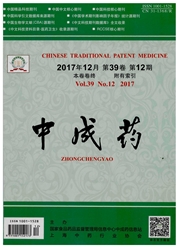

 中文摘要:
中文摘要:
目的 比较滇龙胆根、茎、叶、花4个部位提取物的保肝抗炎作用。方法 用刀豆蛋白A致小鼠免疫性肝损伤模型比较滇龙胆4个部位提取物的保肝作用;用二甲苯致小鼠耳肿胀模型比较它们的抗炎作用。结果 滇龙胆各部位提取物能剂量依赖性地降低刀豆蛋白A致肝损伤小鼠血清中的谷丙转氨酶(ALT)和谷草转氨酶(AST)活性,减少其肝指数,减轻肝组织损伤,且叶和根的药效要优于茎和花;滇龙胆各部位提取物能剂量依赖性地减轻二甲苯致炎小鼠的耳肿胀程度,且叶和茎的抑制作用要优于花和根。结论 滇龙胆根和叶提取物有较好的保肝作用,叶和茎提取物有较好的抗炎作用。
 英文摘要:
英文摘要:
AIM To compare liver-protective and anti-inflammatory effects of extracts from root, stem, leaf, and flower of Gentiana rigescens. METHODS The mouse model for the immunological liver injury induced by Concanavalin A, and mouse ear swelling model for inflammation caused by dimethylbenzene were used for the comparison of the liver-protective or anti-inflammatory effects of four parts individually. RESULTS Four aqueous extracts of Gentiana rigescens showed the dose-dependent decrease in the activity of ALT and AST in serum and liver index, and alleviation of hepatic tissue injury induced by Concanavalin A in mice. The effects of the extracts from the leaf and root were better than those from the stem and flower. These extracts presented dose-dependent inhibi- tion against the ear swelling caused by dimethylbenzene in mice. The effects of the extracts from the leaf and stem were better than those from the flower and root. CONCLUSION Extracts from the root and leaf of G. rigescens have liver-protective effect, and parts from the stem and leaf have anti-inflammatory effect.
 同期刊论文项目
同期刊论文项目
 同项目期刊论文
同项目期刊论文
 Labedella endophytica sp. nov., a novel endophytic actinobacterium isolated from stem of Anabasis el
Labedella endophytica sp. nov., a novel endophytic actinobacterium isolated from stem of Anabasis el 期刊信息
期刊信息
